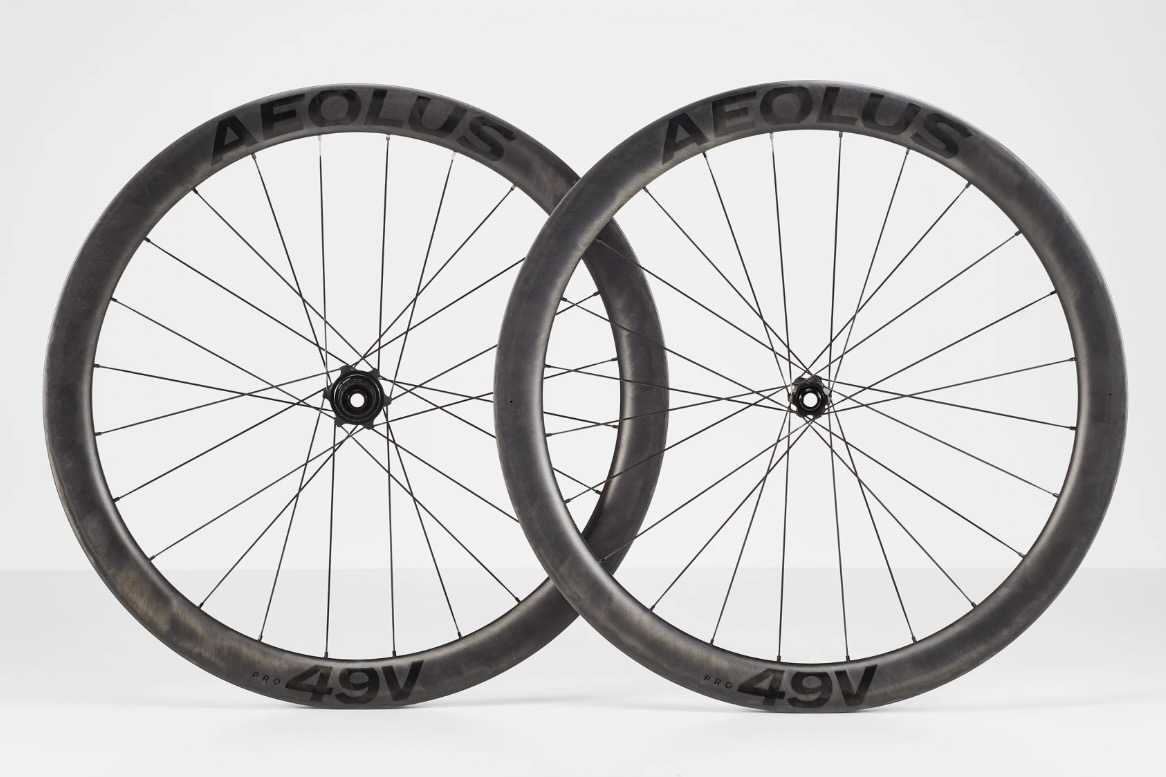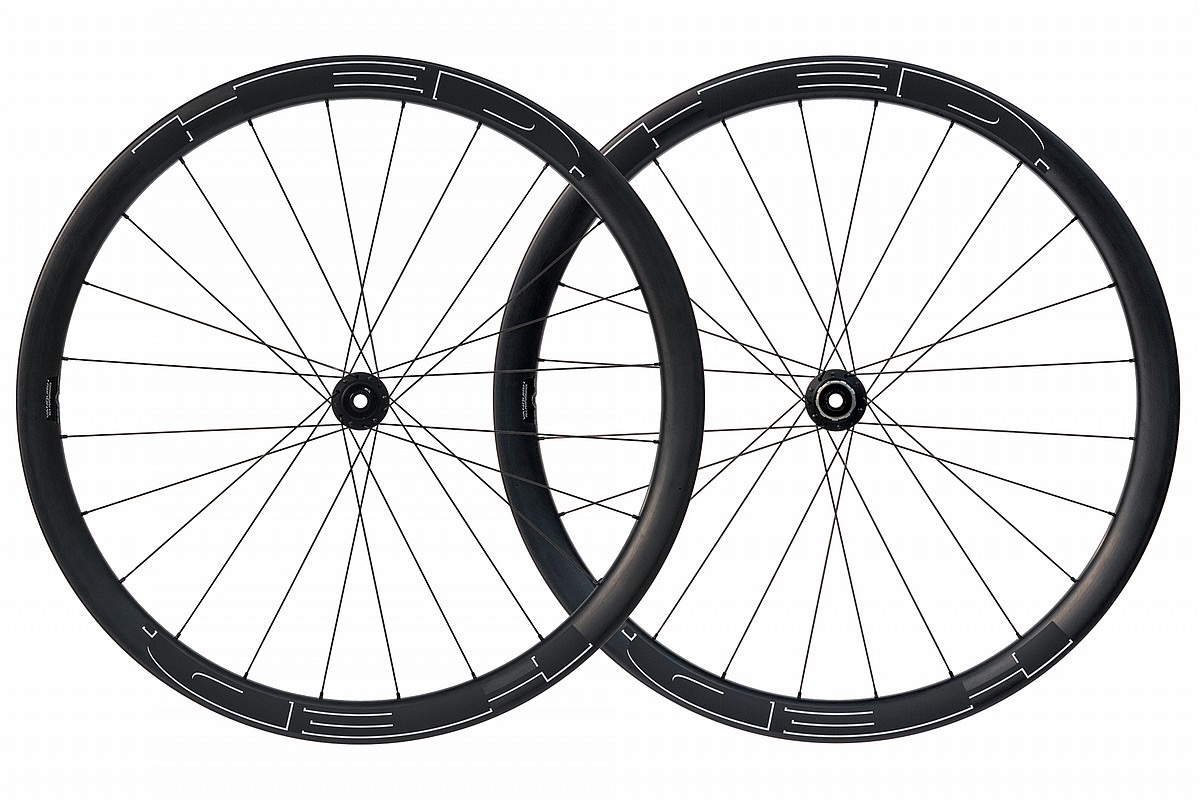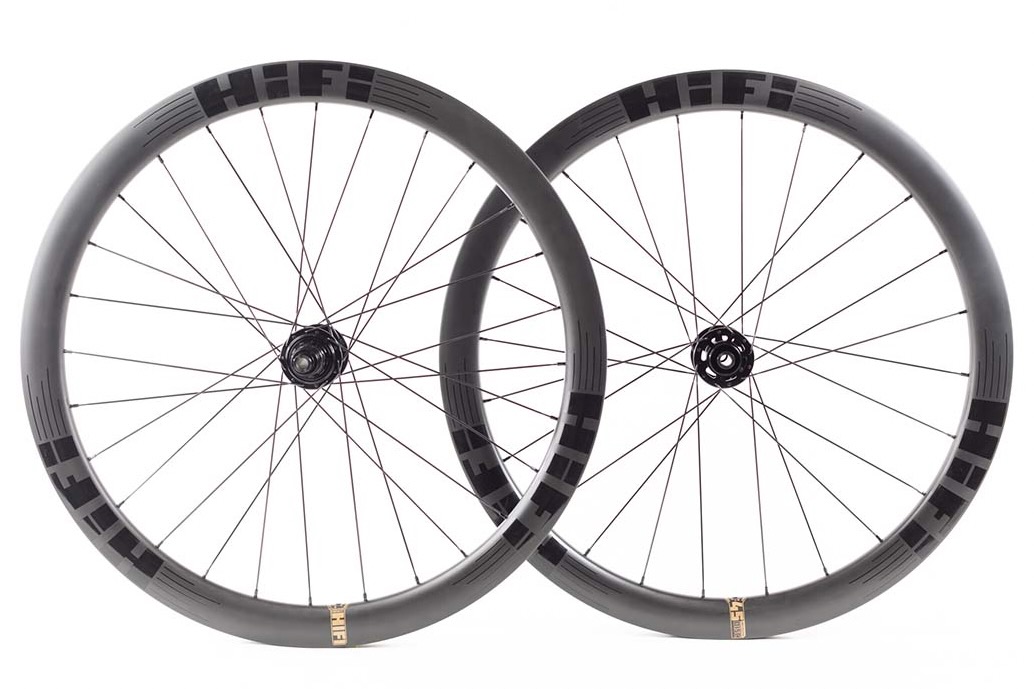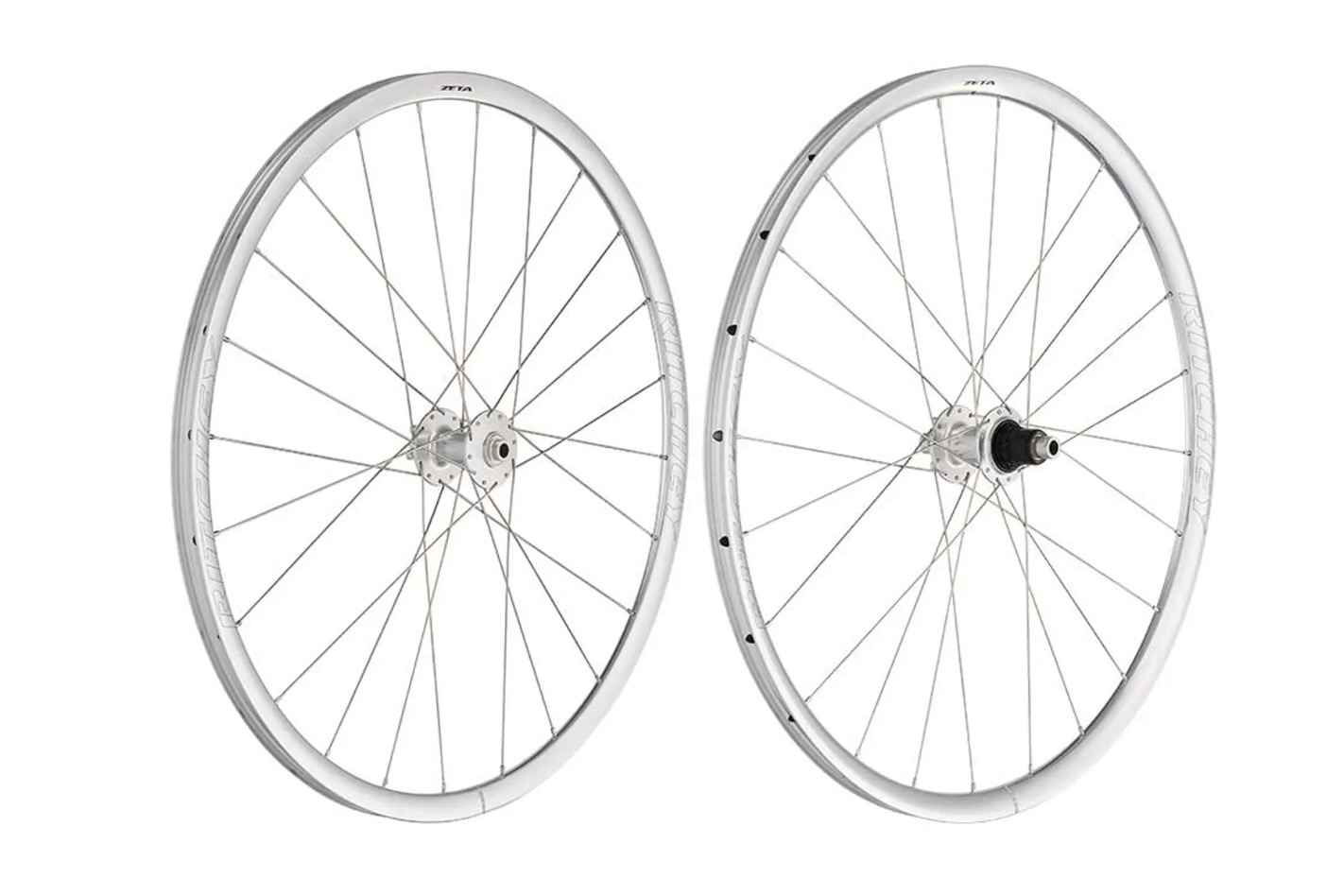When it comes to road bike components, a quality set of wheels is one of the biggest performance upgrades you can make. Whether you’re looking to improve aerodynamics, reduce weight, or simply improve the ride feel of your bike, there are lots of great options to suit every need and preference.
Of course, having all those options can make deciding which road bike wheels to buy a challenge, especially when every brand and model claims to be better than the next. And, the rapid evolution of road bike wheels in recent years means that choosing the right wheels has gotten even more confusing than it used to be. Carbon, aluminum, disc brake, rim brake, rim depth, rim width, hookless tubeless, hooked tubeless, or clincher? There are so many options these days it could make your head spin.
To help provide some clarity, we’ve tested a huge selection of the best road bike wheels on the market to provide honest feedback about how they perform in the real world. Each set of wheels was tested by review author Bennett Shane or another member of our editorial team. Over hundreds of miles of riding, we examined and scrutinized each model’s performance while considering important factors like weight, stiffness, stability, vibration damping, aerodynamics, tire compatibility, and overall build quality.
Whether you’re a climber looking for a snappy and feathery set of low-profile rims, a breakaway addict looking for a set of “deeps” to save every watt of drag possible, or a roadie with an uncanny knack for getting lost on gravel, we’ve tested many of the most popular models and some lesser known newcomers to help you decide on this crucial upgrade.
Among the models we’ve tested, we zeroed in on our favorites which are listed below, followed by the best of the rest which are also great options we feel are worthy of consideration. To see all the models we tested at a glance, check out our comparison chart, and if you need help deciding what you need, take a look at our buying advice and FAQ section.
The Best Road Bike Wheels of 2024
- Best All-Around Carbon Road Bike Wheels: Reserve 40|44 DT 350
- Best Value Carbon Road Bike Wheels: Hunt 44 Aerodynamicist Carbon Disc
- Best Carbon Disc Climbing Road Bike Wheels: Cadex 36 Disc
- Best All-Around Aluminum Road Bike Wheels: Roval Alpinist SLX
- Best All-Around Road Bike Wheels for Rim Brakes: HED Ardennes RA Black
- Best Climbing Road Bike Wheels for Rim Brakes: HiFi EP30 SL Rim Brake Carbon Clinchers
- Best Entry-Level Race Wheels: Vision Trimax 35 DB CL
- Most Elegant Road Bike Wheels: Chris King ARD44
Reserve 40|44 DT 350
Pros
- Plush ride quality
- Responsive performance
- Choice in hub spec
- Minimal branding
Cons
- Not the lightest
- No stock Campagnolo freehub option
Hunt 44 Aerodynamicist Carbon Disc
Pros
- Affordable for carbon
- All the freehub body options
- Come with rotor lock rings, tape and valves
- Great ride quality
- Quick engagment
Cons
- Test wheels trapped water inside
- 240 lbs weight limit
Cadex 36 Disc Tubeless
Pros
- Incredibly responsive
- Predictable and confident handling
- Comfortable ride
Cons
- Tire choice is limited to hookless tubeless only
- Expensive
Roval Aplinist SLX Disc
Pros
- Excellent hubs
- Great handling
- Comfortable
- Reasonably lightweight
Cons
- Could be wider
HED Ardennes RA Black
Pros
- Serious braking power
- Exquisite ride quality
- Looks the business
- Perfectly built
Cons
- None
HiFi EP30 SL Rim Brake Carbon Clinchers
Pros
- What is gravity?
- Micro-hooked tubeless rims for the win
- Sensible width for rim brake frame clearances
Cons
- Replacement spokes may take time to source
- Expensive
Vision Trimax 35 DB CL
Pros
- Excellent lateral stiffness
- Affordable speed
Cons
- Narrow by today’s norms
- 3-pawl freehub engages less quickly
Chris King ARD44
Pros
- Flat out gorgeous
- Unbeatable comfort
- Built to last – lifetime warranty
- Recyclable rims
- Made in USA
Cons
- Your new bank balance
- A tad heavier than similarly priced options
Best of the Rest
Zipp 303 Firecrest Tubeless Disc
Pros
- Versatile
- Light
- Comfortable
- Lighting quick acceleration
- Balances aerodynamics and handling
Cons
- Tire options limited to hookless tubeless
Pros
- Wide rims for higher volume tires
- Lighting quick acceleration
- Comfortable
- Recyclable rims
Cons
- None
Pros
- Top-notch handling
- Compliant ride quality
- Excellent hubs
Cons
- Expensive
- Hookless rims limit tire options
- Internal nipples not ideal with tubeless tire
Shimano Dura-Ace C50 Tubeless Disc
Pros
- Priced less than many high-end competitors
- Fast everywhere
- Look the business
- Compatible with any road tire
Cons
- Compatible only with Shimano cassettes
- Hubs require proactive maintenance
- Not as wide as many compeititors
OTHR Anywhr 40
Pros
- Light
- Comfortable
- Top-shelf build
- Versatile
Cons
- Still moderately expensive
- Silver Holographic decals are super flashy (also come in black)
Shimano 105 C32 Tubeless Disc (WH-RS710)
Pros
- Top-notch handling
- Compliant ride quality
- Affordable
Cons
- Hubs require proactive maintenance
- Compatible with Shimano cassettes only
Pros
- Aero gains you can feel
- Fair price for a carbon wheelset
Cons
- Heavier than some of the competition
- Narrower internal width
Pros
- Stiff
- Lighting quick acceleration
- Comfortable
Cons
- A bit heavier than other 40mm deep options
Pros
- Lightweight and aero
- Excellent hubs
- Razor sharp handling
- Lifetime warranty
Cons
- Expensive
- 12 speed freehubs sold separately
Pros
- Stiff
- Lighting quick acceleration
- Comfortable
- Balanced aerodynamics and
Cons
- Heavier than other 45mm options
Pros
- Classic aesthetics
- Comfortable ride
- Smooth handling
- Affordable quality
Cons
- Not ideal for tires >28c
- 6-bolt disc rotor interface only
- Heavier weight
Comparison Chart
| Wheel Model | MSRP | Weight | Tubeless? | Rim Material | Brake Type | Depth | Internal Rim Width |
|---|---|---|---|---|---|---|---|
| Reserve 40|44 DT 350 | $1,799 | 1460g | Hooked Tubeless | Carbon | Disc | 40mm (f), 44mm (r) | 25.5mm (f), 25mm (r) |
| Hunt 44 Aerodynamicist | $1,279 | 1528g | Hooked Tubeless | Carbon | Disc | 44mm | 20mm |
| Cadex 36 Disc | $3,200 | 1354g | Hookless Tubeless | Carbon | Disc | 36mm | 22.4mm |
| Roval Alpinist SLX | $800 | 1485g | Hooked Tubeless | Aluminum | Disc | 24mm | 20mm |
| HED Ardennes RA Black | $1,300 | 1475g | Hooked Tubeless | Aluminum | Rim | 24.5mm | 21mm |
| HiFi EP30 SL Rim Carbon | $1,970 | 1320g | Hooked Tubeless | Carbon | Rim | 30mm | 19mm |
| Vision Trimax 35 DB CL | $550 | 1650g | Hooked Tubeless | Aluminum | Disc | 35mm | 19mm |
| Chris King ARD44 | $2,850 | 1525g | Hookless Tubeless | Fusion Fiber | Disc | 44mm | 25mm |
| Zipp 303 Firecrest | $2,046 | 1352g | Hookless Tubeless | Carbon | Disc | 40mm | 25mm |
| Bontrager Aeolus Pro 49V | $1,800 | 1555g | Hooked Tubeless | OCLV Carbon | Disc | 49mm | 25mm |
| ENVE SES 3.4 | $2,850 | 1455g | Hookless Tubeless | Carbon | Disc | 39mm (f), 43mm (r) | 25mm |
| Shimano Dura-Ace C50 | $2,100 | 1461g | Hooked Tubeless | Carbon | Disc | 39mm (f), 43mm (r) | 21mm |
| OTHR Anywhr 40 | $1,749 | 1360g | Micro-Hooked Tubeless | Carbon | Disc | 40mm | 24mm |
| Shimano 105 C32 | $1,050 | 1504g | Hooked Tubeless | Carbon | Disc | 32mm | 21mm |
| Reynolds AR 58 | $1,450 | 1700g | Hooked Tubeless | Carbon | Rim | 58mm | 19mm |
| HED Vanquish RC4 Performance | $1,750 | 1542g | Hooked Tubeless | Carbon | Disc | 40mm | 21mm |
| Bontrager Aeolus RSL 51 | $2,700 | 1410g | Hooked Tubeless | OCLV Carbon | Disc | 51mm | 23mm |
| HiFi The 45 Disc Carbon | $2,090 | 1520g | Hooked Tubeless | Carbon | Disc | 45mm | 21mm |
| Ritchey Classic Zeta Disc | $449 | 1750g | Hooked Tubeless | Aluminum | Disc, 6-Bolt | 23.4mm | 19.5mm |
Why You Should Trust Us
At Bikerumor, we love riding our bikes and we’re always seeking out the latest and greatest products to help improve our performance and enhance our experience out on the road. And, we know that a quality set of road bike wheels is one of the best performance upgrades you can make. Fortunately, we’re always testing out fresh new wheels, and we get to try just about everything on the market. This gives us the opportunity to pass along our experience and help you navigate the myriad options that are out there.
For this buyer’s guide, author Bennett Shane did a large group test including the majority of the models included, supplemented by a few models that our editorial team has tested and loved. Bennett is an avid road cyclist who has been riding seriously for over two decades. Though his racing days are largely behind him, he still rides obsessively for fun, fitness, and to test out a huge range of cycling products for reviews. Bennett spent many years working at various prominent brands in the cycling industry and is about as knowledgeable as one can be about cycling products and technologies from apparel to components. His road cycling and industry experience combine to give him a keen ability to analyze the gear he tests, and we’ve called on that skill a lot lately for a huge range of road cycling-specific buyer’s guides. In addition to road bike wheels, Bennett has tested apparel like cycling bib shorts and jackets, components like road bike pedals, and accessories including road bike shoes and helmets.
To test wheels, we received each model and set up each wheelset tubeless. For the vast majority of the wheels included here, we used the Vittoria Pro Control TLR in 28mm as a control tire, although a few models were tested with other road bike tires for various reasons. We used Silca’s Tire Pressure Calculator to ensure that tire pressure was optimal and in most cases rode the wheels over the same test route to compare them in the same scenarios and surface conditions. The primary test route features flat, rolling, and hilly terrain with climbs topping out at around the 25-minute mark for a well-trained rider. We also intentionally rode deeper wheels whenever windy conditions arrived, to test their stability. We did not use a wind tunnel to verify any aerodynamic claims made by manufacturers, instead, we chose to focus on the tangible things that most riders care about, such as ride quality, handling, acceleration, durability, and serviceability, including warranty and crash replacement provisions.

Buying Advice: How to Choose Road Bike Wheels
With so many road bike wheels to choose from, finding the right set of new hoops can seem like a daunting proposition. Some considerations are pretty straightforward, like choosing wheels for disc or rim brakes, but there are many other factors to weigh when making a purchase decision. Below, we provide a little explanation about choices in rim material, rim width, rim depth, tire compatibility, freehub bodies, and more.
Rim Material
The material used in the construction of the rims is one of the biggest factors separating aftermarket road bike wheels. Most road bike rims are made from either aluminum or carbon fiber and there are great wheels being produced in either material.
Carbon Fiber

Since carbon wheelset pricing starts above where aluminum wheels typically max out, it’s fair to assume that simply by choosing a carbon fiber wheel, your bike will instantly be much lighter. In reality, carbon fiber rims are often no lighter than aluminum rims, and depending on the depth of the rim, can often result in a hefty wheel that won’t be particularly fun for climbing. Of course, aerodynamics are a bigger concern than weight for many riders, and here carbon fiber has an undeniable advantage over aluminum, in that it can molded into an array of shapes to cheat the wind.
While rim material has only a fraction of the effect on ride quality as tires do, carbon rims do typically give any bike a more damped, efficient ride quality, most noticeable on rougher surfaces. Carbon fiber, and more specifically the interfaces in the composite structure, have a greater ability to absorb high-frequency vibration than aluminum. This feeling has been enhanced by the advent of disc brakes, as engineers are now free to design the rim/tire interface with no braking in mind. With the brake track out of the picture, the trend has been to use less carbon at the outermost edge of the rim, and to size and shape the carbon such that it promotes better shock absorption and lower rolling resistance through the tires.
The primary downside to carbon fiber is that it is expensive, with carbon wheels often costing double that of their aluminum counterparts. And, until very recently, carbon fiber rims haven’t been the most environmentally friendly given the difficulty of recycling the material. A small handful of brands are now making carbon fiber rims with thermoplastic resin that makes them more easily recyclable including the Chris King ARD44 wheels which are made with thermoplastic Fusion Fiber.
Aluminum

Aluminum has been used for many years in the production of road bike wheels and is generally much more affordable than carbon fiber. Not only is the raw material less expensive, but the production costs are also typically much lower. As a result, most aluminum road bike wheels are less expensive, though there are still plenty of premium aluminum options. Due to the lower cost, many low to mid-range complete bike builds will usually come with aluminum wheels/rims. This is not to say that wheels made with aluminum rims won’t be a performance upgrade over a set of cheaper stock wheels, far from it. In fact, there are aluminum wheels that rival their carbon counterparts in terms of both weight and ride quality, while beating them handily when it comes to price. A prime example is the Roval Alpinist SLX, which at $800 are much more affordable than premium carbon options without giving up much in terms of performance.
Rim Width

Road rims have grown in width recently to improve their compatibility with the corresponding growth in the width of road bike tires. Some brands and models are now at 25mm in internal width, a 20% increase in some cases from just a few years ago. The width refers to the internal distance between the bead hooks on the inside of the rim, not the external width including the bead walls. Increasing internal width improves the relationship between the rim and tire, particularly when using wider tires. Wider modern road tires in the 28-32c range will take on a more domed shape with slightly larger air volume when mounted to a wider rim, thus improving the aerodynamics of the rim/tire system as a whole, while reducing rolling resistance, improving handling, and boosting comfort through a larger volume of air.
In our opinion, rims narrower than 21mm (internal) are almost outdated at this point. Rims in the 21-23mm wide range are adequately wide for any true road tire. Rims with 25mm internal width are designed and intended to be able to accommodate road and gravel tires that are upwards of 40mm in width, so while not any disadvantage, per se, this rim width means those rims will typically only work for tires 28c and wider. That said, those who like to explore smooth gravel or poorly maintained paved mountain roads may enjoy the benefits of a wider rim paired with a plumper all-road tire. It is worth mentioning that since older frames, whether made for rim or disc brakes, may be designed to only clear a maximum of 25mm, you’ll want to check out the areas of your frame and fork where clearance is tight, to ensure that newer, wider rims will be compatible and safe to ride.
Rim Depth

With many aftermarket road bike wheels being made for purposes like aerodynamics or climbing/lightweight, the rims themselves are being designed differently for their specific use cases. One of the most obvious and visible differentiators is the depth of the rims which range from deep to shallow, and everything in between. In general, the deeper a rim gets, the more aerodynamic it becomes, so aero wheels typically have a taller rim profile, usually 40-50mm and above. While deep section rims can provide aerodynamic benefits, the extra material needed to construct them can add weight and the additional structure can present as stiffer and less forgiving than lower-profile options. Aero rims are also more susceptible to the effects of cross winds which can impact your bike’s stability and handling in gusty conditions.
Shallow section rims typically don’t provide the same aerodynamic benefits as deeper aero rims, but they are generally lighter-weight and the lower profile of the rim allows them to be a bit more compliant. While that is a very broad generalization, most super light climbing wheels also happen to be relatively low-profile. Many modern all-around wheels have a mid-section depth, 30-40mm or so, which aims to balance the attributes of low weight, ride quality, and aerodynamic benefits. These are often the best choice for riders who want a wheelset that performs day in and day out on any type of ride.
Tire Compatibility

Virtually all road bike wheels being produced these days are compatible with some tubeless road tires. However, you need to be sure that you use tires that are compatible with your specific rims. Each type of rim has advantages and drawbacks. This is particularly true of hookless tubeless rims which are not compatible with all tubeless tires and are wholly incompatible with clincher tires. Hookless tubeless rims have comparatively limited tire options and should only be used with ETRTO-approved hookless tubeless tires, but provide the best impact protection for the rim, and complement larger, 28-32c tires best. While many of the best road bike wheel manufacturers in the business are making hookless road rims and wheels, there is plenty of lively debate about hookless rims and tires for road riding.

Hooked tubeless-ready rims feature a small bead “hook” that is intended to provide added security with the bead of the tires. Hooked tubeless rims offer compatibility with any tire, but are slightly more vulnerable to impact and may incur a very slight aero penalty at the rim-tire interface in some cases. Clincher rims may still be available but have dwindled with the industry-wide transition to tubeless. Clincher tires are compatible with tubeless-ready hooked and micro-hooked rims but require a tube. Clincher rims and tires are easy to set up and maintain if you’re okay with foregoing tubeless technology.
-Hookless tubeless rim compatibility: APPROVED hookless tubeless tires (with or without inner tube)
-Hooked tubeless-ready clincher rim compatibility: ALL tubeless and clincher tires (with or without tube)
-Clincher rim compatibility: ALL tubeless and clincher tires (WITH innertube)
Brakes and Axles

Almost every new bike released in 2023 and 2024 is being made for use with 12mm thru-axles and disc brakes with a few exceptions. And after years of mixing road and MTB technology together to form a maelstrom of “standards”, things have settled down and are more straightforward in terms of wheel-to-frame and hub-to-brake compatibility. The standards are below.
-Axles: 100mm x 12mm front; 142mm x 12mm rear.
-Brake rotor interface: Center lock is the most common by far, although there are some 6-bolt hubs available as well.
There are still plenty of folks who prefer rim brakes and there are quite a few rim brake frames in use (and some still being produced), so they are still relevant but less common. Fortunately, there are still quite a few wheels being produced for rim brakes, and we tested a few of the best options available. The HED Ardennes RA Black and the HiFi EP30 SL Rim Brake Carbon wheels are a couple of our favorites.
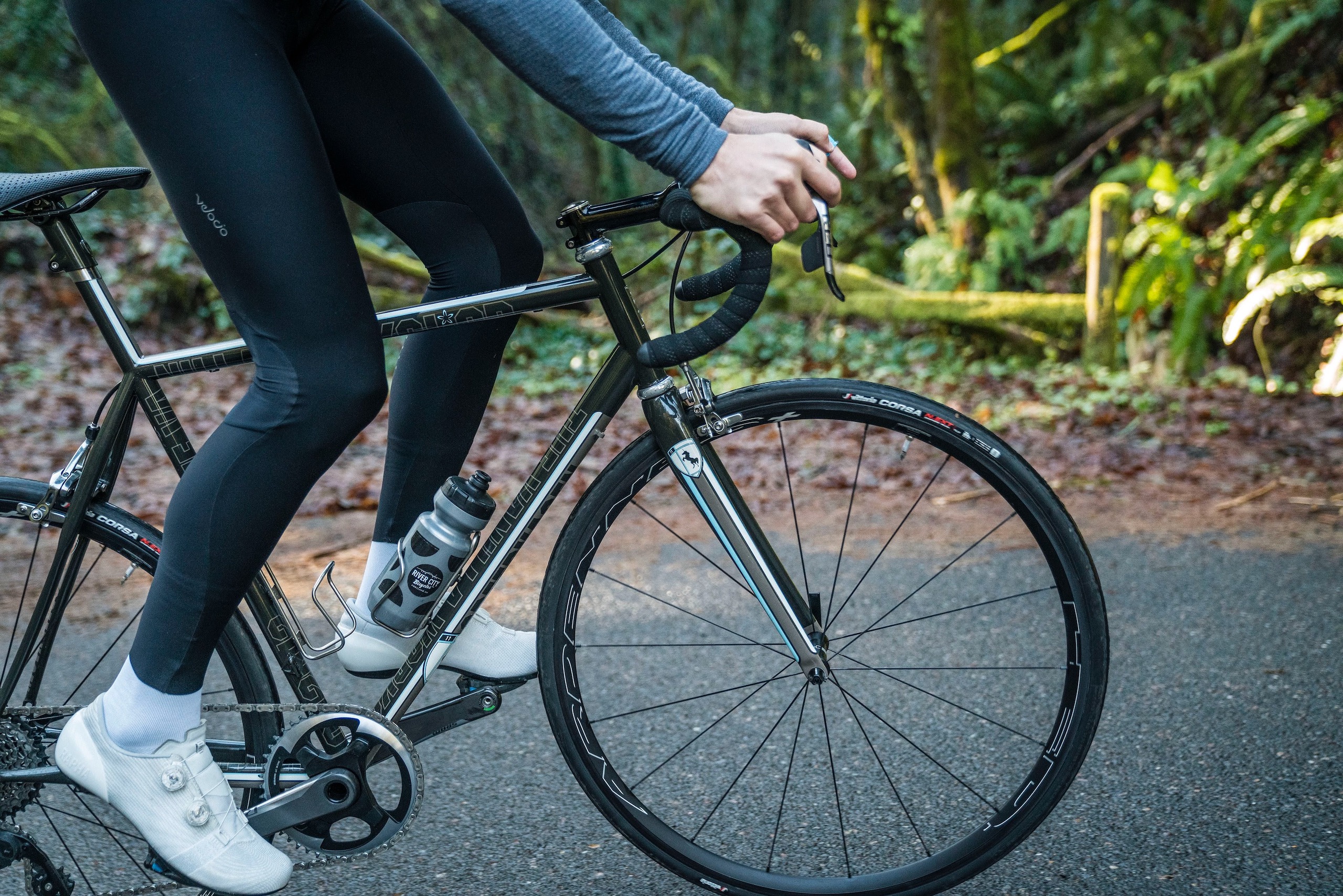
Many of you reading this may have bikes made from 2013-2018 that use disc brakes but also have dropouts made for traditional quick-release skewers (9mm) to hold the hub axles in the frame and fork. Therefore, you’ll need to confirm that any wheel you purchase to upgrade this bike can be converted to quick-release axles with different end caps. This is done by changing the end caps and is an easy job, assuming that quick-release end caps are included or available for the wheels you are choosing.
Freehubs

When selecting wheels online, the vendor will typically present a menu of freehub options that correspond to the type of cassette that will be mounted on the hub rear wheel. Options will include Shimano HG, SRAM XDR, Campagnolo, and possibly Shimano Mircospline. If the option you need isn’t available at the time of purchase, it likely can be ordered directly from the manufacturer separately, at an additional cost. Most wheel and hub manufacturers make a full assortment of freehub bodies, with some notable exceptions, the most glaring of which is Shimano, which only offers freehubs that are optimized for its own Hyperglide and Microspline cassette interfaces. While other 11-speed cassettes, and 12-speed cassettes from alternative brands, like Rotor and KMC, are compatible with Shimano wheels, SRAM and Campagnolo 12-speed cassettes are not.
Freehub Engagement
Freehub engagement is an often overlooked aspect of road wheel performance and is a big deal for riders who like to ride in hilly terrain or race. Without getting too technical, higher engagement hubs decrease the number of degrees between engagement points and therefore the delay from when your power hits the pedal to when the cassette engages, and that power is translated into forward progress. While freehub engagement speed is arguably less important in road cycling where riders typically spin the pedals at a smoother, more even cadence than mountain bikers or gravel riders, quick engagement is appreciated by many on the road as well. Hubs using at least 5 “pawls” or a “ratchet” system will provide this rapid engagement, and you’ll feel it working when hopping out of the saddle on a steep climb or accelerating hard out of a corner.
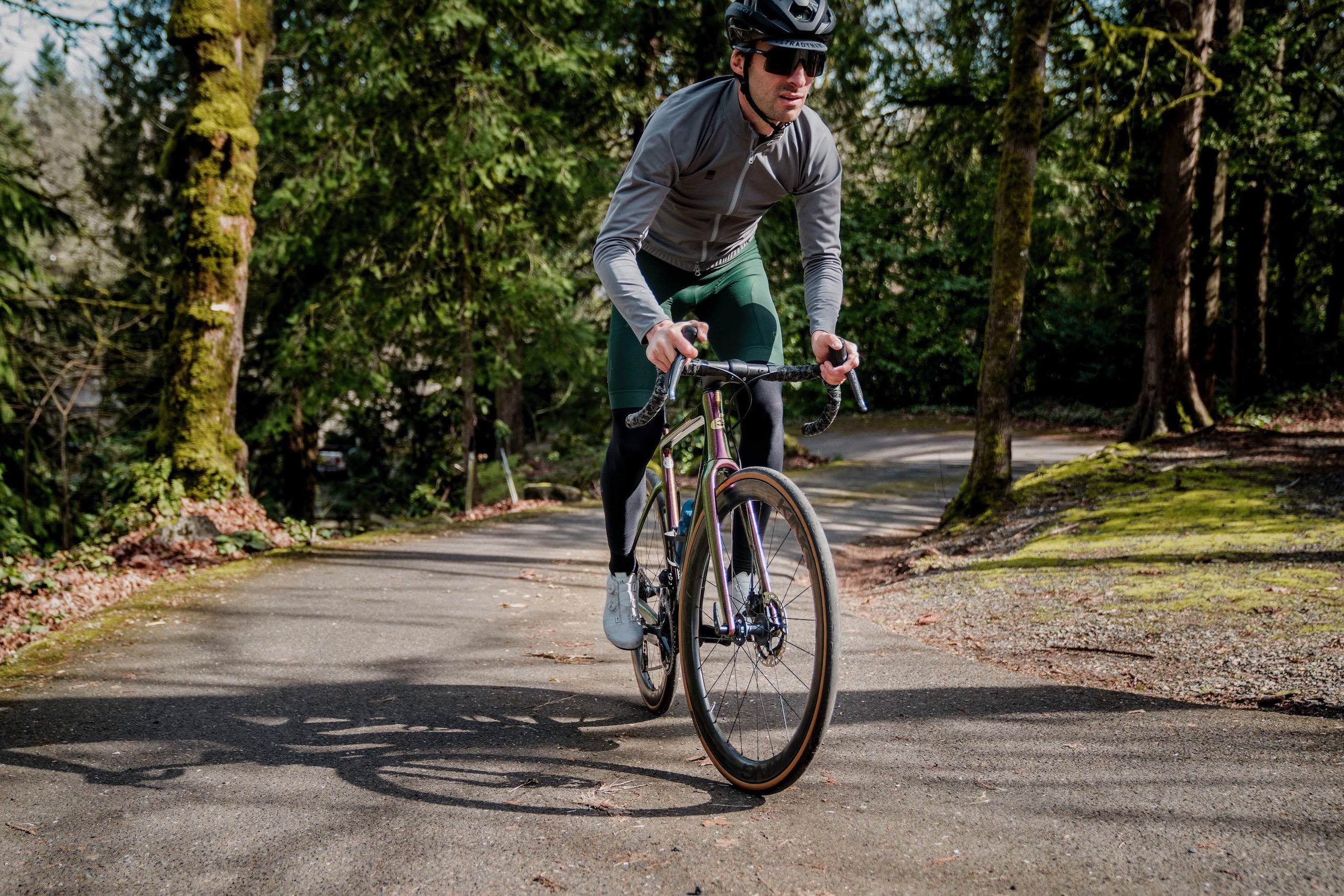
Hub Bearings
The majority of road bike wheels spin on steel bearings because they are more affordable, work well, and typically last a pretty long time. Ceramic bearings are a popular upgrade option in ultra-premium wheels. Harder than steel, with a smoother surface and more uniform dimensions, ceramic bearings distribute the load equally across every ball while also reducing friction. The result is less power required from the rider to spin the bearing. Without exposure to extreme contamination from road spray or pressure washing, ceramic bearings may outlast steel bearings in most situations. Good thing, too, as they cost as much as some nice wheelsets to replace if they ever do wear out. The bottom line is that cycling never gets easier, you just go faster, so if you’re looking for wheels to change the way your bike rides, ceramic bearings are not necessary. If you’re looking for every possible efficiency gain for your next race, or to own every piece of bling kit under the sun, then go ceramic. If you’re ceramic-curious but it’s not an option at the time of purchase, you can typically upgrade down the line.
Spokes

Spoke count refers to the number of spokes connecting the hub to the rim. Generally speaking, the more spokes used to build a wheel, the stiffer, more durable, and heavier that wheel is. Spoke quality, nipple material, build quality, rim design, rider weight, and especially use case all factor into determining the correct spoke count for your next wheelset. But spoke count alone should not be used as a threshold for a wheel to be considered durable, stiff, or safe. High-quality spokes, laced to well-designed rims by hand will often facilitate a lower spoke count with no compromises on stiffness and durability.
Internal nipples on tubeless rims can be problematic from a maintenance standpoint. While this design may offer a small aerodynamic advantage and offer svelte aesthetics, it also requires removal and reinstallation of the tubeless tire system to make adjustments to spoke tension. It’s an added cost or time requirement that is something to be aware of.
Carbon spokes are becoming more prevalent, and while they tangibly improve responsiveness, the potential downtime to source replacements makes this a choice worthy of shrewd judgment. If you’re on the lighter side, tend to ride smooth roads that are close to home, and have the budget to preemptively order some compatible spares, carbon spokes are a nice upgrade. All mid-range and high-end spokes are bladed or butted to varying degrees. These features help increase strength, improve ride quality, save weight, and enhance aerodynamics. Straight pull spokes also bolster responsiveness and overall wheel strength. Top spokes include Sapim CX-Ray and Sprint, DT Swiss Aerolite, and Aerocomp, but numerous options compete with these. If a wheelset doesn’t disclose the type of spoke used in the build, or only the brand, it’s worth digging to find out, as this part of the wheel is sadly often used as a cost-control measure, and yet is critical to how a wheel feels, performs, and holds together long-term.

Value
While a nice set of aftermarket wheels can absolutely be a major performance upgrade, many premium options cost more than some complete bikes. Fancier materials, high-end hubs, ceramic bearings, carbon fiber production costs, and lots of engineering may factor into the price of many wheels to make the price higher. Of course, if cost isn’t a concern, then some of the super-premium wheels like the Chris King ARD44 or the Cadex 36 Disc may be just the ticket to transform the way your bike rides. Still, many of the performance gains may only truly matter to high-performance cyclists and racers.
If, like most people, you aren’t swimming in cash, then there are some better values to be found in more moderately priced wheels with performance differences that will likely be negligible. Of course, when we say “moderately priced” we are talking about wheels in the $1,500 to $1,800 range, like the Reserve 40|44 DT 350, or the OTHR Anywhr 40, which still probably sounds expensive to lots of people. But, when compared to wheels that cost $2,500 or more, they are certainly more affordable, comparatively speaking.
Since even mid-range road bike wheels will still be out of many people’s budget, it’s good to know that there are quite a few aftermarket options that will blow the performance of most stock wheels out of the water. A couple of good examples are the $800 Roval Alpinist SLX or the $550 Vision Trimax 35 DB CL wheels. These wheels may be made with aluminum rims, but they perform well while costing a fraction of the price of many of the high-end competitors.

Frequently Asked Questions
The wheels on your road bike are one of the components that can have a noticeable impact on the performance of your bike and your comfort and enjoyment on the road. The stock wheels that come on many complete bikes, particularly low-mid priced builds, are often chosen not for their performance, but as a way for brands to save money. By investing in a quality set of aftermarket wheels, you can choose a model that offers specific performance benefits to suit your needs and preferences.
Deep-section aero wheels can provide improved aerodynamics to help powerful riders or racers move faster. Feathery climbing wheels can help riders get up hills faster. Mid-depth all-around wheels can do everything pretty darn well and many wheels can enhance the ride quality of your bike through vibration-damping, resulting in a smoother, faster ride with greater control, comfort, and less fatigue.
When considering a road bike wheel upgrade, that usually means spending money with the goal of improving your bike’s performance and enhancing its ride quality. More often than not, this means shelling out big bucks for a wheelset with carbon fiber rims. While there are plenty of excellent aluminum wheelsets on the market, carbon fiber does have some advantages.
Carbon rims are generally lighter than comparable aluminum rims. Carbon fiber absorbs vibration more readily than aluminum for a smoother, more comfortable ride. Carbon can also be manipulated in ways to produce specific shapes and performance characteristics. Carbon is also very strong, and many rims come with exceptional warranties (lifetime in some cases) that can help justify the higher price. And, while carbon wheels have traditionally been very pricey, some brands and models are now only just a little more expensive (or less) than nice aluminum models. Hunt is a good example, as their Aerodynamicist wheelset costs $1,279.
There’s a reason that time trialists wear silly helmets and ride deep-section wheels when they’re racing. Aerodynamics matter. The benefits of aero road wheels may not be worth the cost for purely recreational riders, but racers who are seeking to squeeze out every marginal gain possible can often find some extra speed and time on the clock by riding them. While the deeper rims add some weight, that is typically offset by the rim’s ability to cut more smoothly through the air. These benefits are most tangible in race situations, flat and rolling terrain, and over time. There are numerous studies and testing results that can be found online that back this up.
That said, deep-section aero rims are often less ideal for climbing due to the added weight, and they can sometimes be less stable in cross-winds compared to shallower rim profiles. For this reason, many manufacturers are producing mid-depth rims in the 40mm range that provide a slight aero advantage while keeping weight lower and reducing cross-wind instability.
The best road bike wheels are the ones that are geared towards the type of riding you do most of the time. Do you spend significant amounts of time climbing big hills? Then a light, feathery, responsive wheelset can help reduce the overall weight of your bike and rotational mass, and make climbing more enjoyable. Do you ride mostly on flat or gently rolling terrain? Then perhaps a deep-section wheel is a good choice to help maximize your aerodynamic gains.
Do you ride all types of terrain? The happy middle ground between the lightweight climbing wheels and the aero wheels is probably the best bet for finding a well-rounded wheelset that does everything pretty darn well. Do you ride rough pavement, sometimes find yourself on well-maintained gravel roads, or switch it up between gravel and road riding? Some of the new, wider (25mm internal) wheels on the market might be the best fit. These wheels work well with bigger all-road and gravel tires which can enhance comfort and control on mixed surfaces.
Hookless rims gained popularity in the mountain and gravel worlds but have recently caught on in road cycling as well. Traditionally, road rims had small hooks on the bead wall (and many still do) that are intended to interface with the bead of the tire for a secure connection between the two. More recently, many road rim and wheel manufacturers have done away with the bead hooks, hence the term hookless, as it makes the rims slightly easier to produce, is claimed to make them more resistant to damage from impact, and the lack of the bead hook provides a smoother transition between the tire and rim and can improve aerodynamics slightly. Without the bead hook, however, hookless rims are only intended for use with ETRTO-approved hookless compatible tires that have been produced to meet higher tolerances on hookless rims. Hookless tubeless rims generally have lower maximum pressures and there is guidance on tire compatibility from ETRTO and from the brands themselves.
Does anyone need to ride hookless tubeless road wheels? Not necessarily, but many of the best road bike wheels on the market use hookless rims. That said, this technology is hotly debated and many riders believe it is unnecessary and unsafe. Regardless of public opinion, hookless tubeless wheel and tire combinations are ridden safely by many thousands of cyclists, and it is here to stay.










